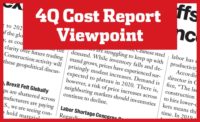The third quarter brought a flurry of natural disasters, including category 4 and 5 hurricanes whose economic impacts will take years to unfold, with Harvey primarily in Texas, Irma in Florida, and Maria in Puerto Rico and the Virgin Islands. Preliminary estimates by Moody’s Analytics puts the total combined economic costs of Harvey and Irma at $200 billion, while Maria could top $95 billion. It is too early to quantify the storms’ impact on construction costs, except to say it will be significant for the labor market and key materials.
Experts say it will take one to two years before the full ramifications show up in construction cost escalation. “After [Hurricane Katrina in] New Orleans, the big spike in construction costs came about a year later,” says Julian Anderson, president of Rider Levett Bucknall.
“The initial hit will come in the disaster response and repair process, affecting building materials, such as lumber, plywood and wallboard, with upward pressure on structural steel and rebar prices coming later as the rebuilding process gets underway,” says John Moreno, chief estimator for Sierra West. “The situation also will aggravate a very tight labor market,” Moreno adds. “We all have our seat belts fastened tight.”
Anderson notes that contractors now bidding on work for 2018 starts are very nervous due to the storms’ economic disruption and the shrinking labor market, which still has not been replenished since workers left the industry after the last recession. “They have to wonder if there will be an adequate workforce to man their up- coming worksites next year,” he says. That uncertainty will inevitably start showing up in higher bids. “We expect subcontractors to start pumping up costs,” says Anderson.
View the full ENR 2017 3Q Cost Report PDF
Besides those factors, Anderson thinks growing anti-immigrant sentiment is throwing fuel on the fire by restricting the flow of a potential immigrant workforce and “even causing some workers to leave the market.” This exodus has a dampening effect on the labor market for crafts such as drywall and painting—in which Hispanics play a major role—and are precisely the crafts that will be in the most demand during the initial repair phase. “Any discouragement puts added pressure on an already stressed labor market,” he adds. Through October, ENR’s 20-city average labor component for its construction cost index was up 3.6% above 2016 (see story, p. 44). ENR’s analysis is that the annual escalation could be up to 4.6% in two years.
One of the biggest unknown storm costs is insurance and what it covers or does not. In Florida, Irma was basically a wind storm, which is broadly covered by insurance. That distinction will help to finance repair and rebuilding costs for many owners. However, Harvey was mostly a water storm, and flooding is usually not covered by most insurance. So, Florida may be in a better position to rebuild than Texas from an insurance financing perspective.
Flooding also presents another cost problem. If disaster relief is not provided promptly, the corresponding costs could go up dramatically: Submerged and saturated properties continue to deteriorate rapidly, and the longer it takes to fix, the higher the costs. “The lack of insurance coverage will [exacerbate] this problem. Ironically, storm-related costs may continue to rise long after the event,” says Anderson. In addition, older structures will have to be rebuilt to contemporary, more expensive codes. It’s just another hidden cost in this complex equation.
Puerto Rico has special cost circumstances. Before the storm, Puerto Rico was suffering from a severe financial crisis. “The island does not have the money to rebuild itself. It will mostly have to come from federal funds,” says Anderson.
However, President Donald Trump has already tweeted his reluctance to provide the total funds necessary. Just rebuilding the island’s power grid will come at an enormous cost, and those that would do the work will need the funding. Uncertainty is perhaps the biggest of all cost drivers: People on the ground need to know what is going on.
The price of gypsum wallboard may be a good barometer of early cost response to the hurricane crisis. “Under normal circumstances, more than half of all wallboard consumption is for residential and non-residential building repair and reconstruction,” says Deni Koenhemsi, construction-materials economist for IHS Markit. “Almost 40% of all gypsum sales are in states that have been affected by Hurricanes Harvey and Irma,” she adds. The implications have led Koenhemsi to issue a “price alert” for wallboard.
“Wallboard prices were already on the rise, with major producers announcing increases ranging from 5% to 20% for this year. In the first half of 2017, prices were already up 7%,” says Koenhemsi. Her latest forecast calls for a 10% increase in 2017, but that may get bumped up. “This marks a clear reversal of slowing inflation for the product recorded in the past two years,” she adds.
Lumber is an even more complex story. “Before the hurricanes, lumber prices were already under tremendous upward pressure due to the wild res in the West and a pending trade agreement on Canadian imports, which will impose countervailing duties,” says Koenhemsi. Between hurricanes, fire and trade, lumber prices never got a break. During the first quarter of this year, they rose 5.1%, followed by another quarterly increase of 6.8%. On a year-to-year basis, lumber prices in the second quarter of 2017 were up 12.4%. “This momentum will only be compounded by the effect of the hurricanes,” Koenhemsi observes.
Koenhemsi’s latest forecast calls for a 10.1% increase in lumber prices this year and a 4.3% hike in plywood prices. But, again, the forecast risks are all on the high side due to the impact of the hurricanes that has not yet shown up in statistics. When the September numbers roll in, “we expect another aggressive quarter in lumber, plywood, OSB panel and products related to roofing and flooring,” says Koenhemsi. Texas and Florida are two of the country’s largest housing markets, so the math is pretty obvious, she adds.
While the total cost impacts of Irma and Maria are still being sorted out the impact of Harvey is becoming clearer. Harvey disrupted the Houston’s port, which is the largest handler of steel imports. This in turn damaged inventory and the supply chain, but the immediate impact on steel prices appears to have been temporary, especially for construction steel products. The Texas storm also led to a quick gasoline price spike, which also appears to have been temporary. “We are not seeing any continued stress on gasoline prices, which have recovered quickly,” says RLB’s Anderson.
Harvey’s more lasting consequences probably will be on petrochemical products, such as plastic construction products. Industrial Information Resources says there were 42 large projects underway in the Houston area, with an estimated value of $7.4 billion. In addition, there were another 19 projects, valued at $2.6 billion, that were scheduled to start in the fourth quarter of 2017. “With flooding, poor site conditions and the inability to move equipment, I don’t anticipate anybody’s projects not being delayed for up to several months,” says an IIR spokesperson.
The storm took 25% of total PVC capacity offline, with another 57% potentially affected, according to a report by Cumming. Expect double-digit price increases for PVC in the next three to six month, the report warns. The Cumming report also notes that FEMA-installed temporary housing has a high PVC content, further exacerbating the problem.





Post a comment to this article
Report Abusive Comment